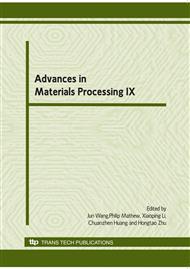p.699
p.705
p.711
p.717
p.723
p.731
p.736
p.742
p.748
Minimizing Stress Concentrations in the Femoral Heads of Hip Joint Prostheses: Effect of Borehole Shapes
Abstract:
This paper presents a stress analysis of the ceramic femoral heads of hip joint prostheses with different borehole shapes to evaluate their mechanical reliability in terms of stress concentration. Under the ideal loading conditions used for ceramic rupture tests specified by the ISO 7206-5 standard, a finite element (FE) modeling is performed to determine the tensile and hoop stress distributions in the ceramic femoral heads. Two borehole shapes that are currently used in the manufacturing industry for hip joint prostheses, namely the flat bottom and keyhole, were first studied. Two new borehole shapes, dome arc and dome ellipse, were then introduced by the authors in the paper to minimize the stress concentration. It was found that while the currently used borehole shapes lead to high tensile notch stresses at their critical corners causing possible fracture failure of ceramic heads, the authors’ borehole designs can improve the mechanical reliability significantly. In addition, the effects of taper-bore contact length and their interface friction are investigated and discussed.
Info:
Periodical:
Pages:
736-741
Citation:
Online since:
June 2010
Authors:
Price:
Сopyright:
© 2010 Trans Tech Publications Ltd. All Rights Reserved
Share:
Citation:


